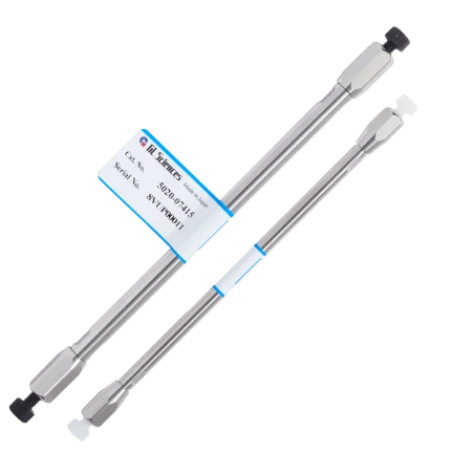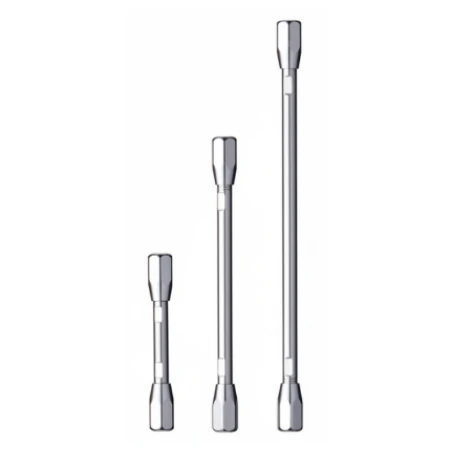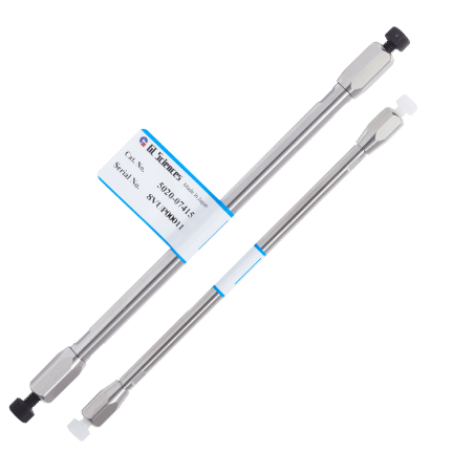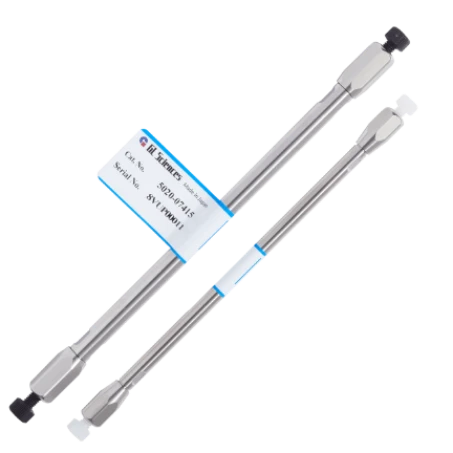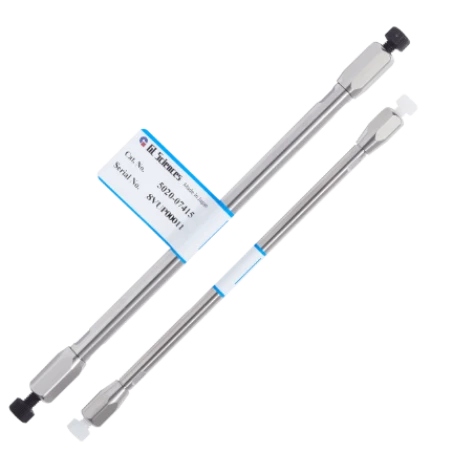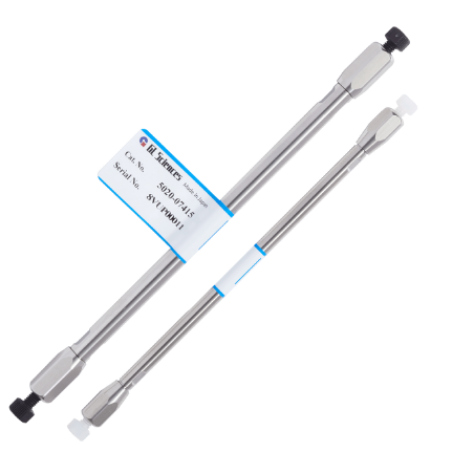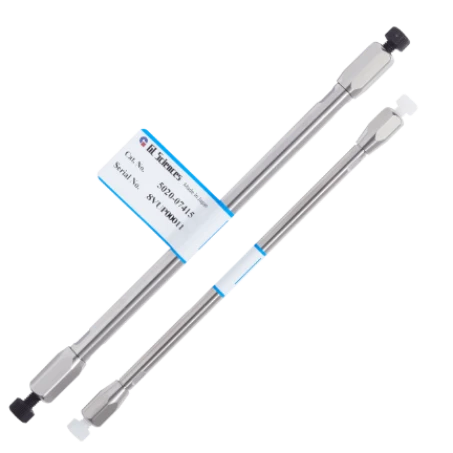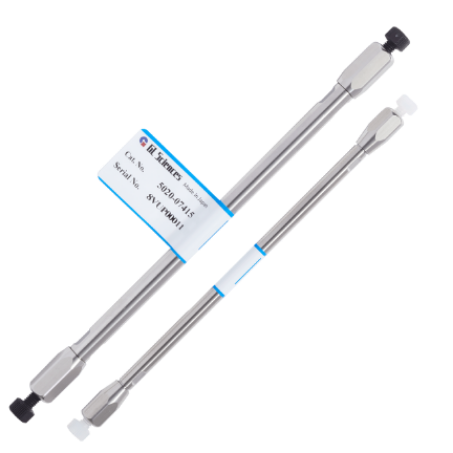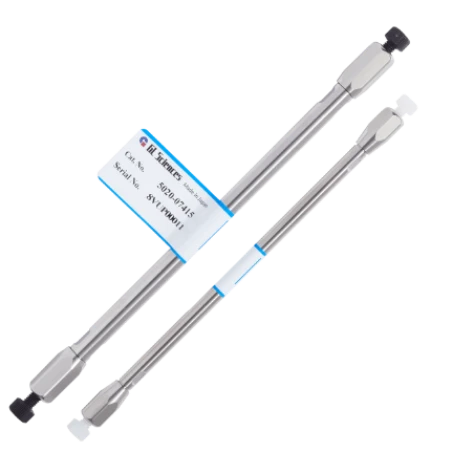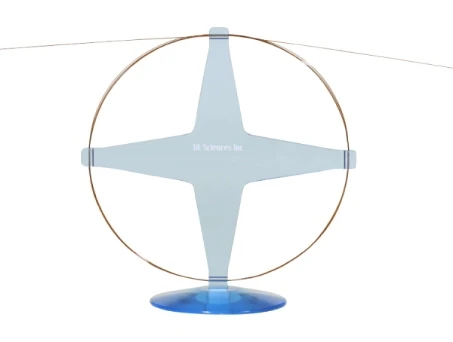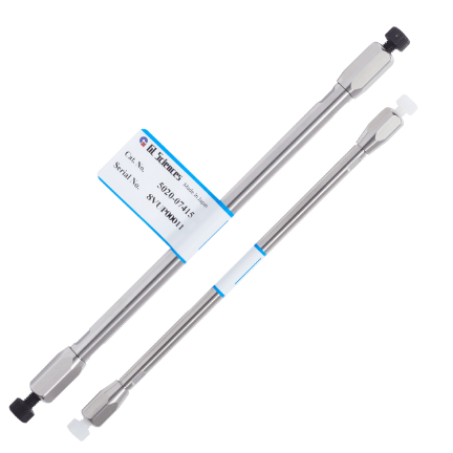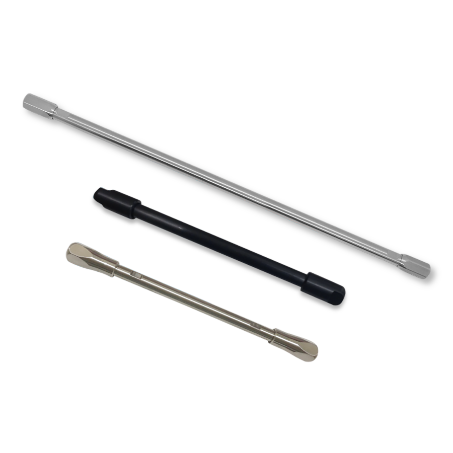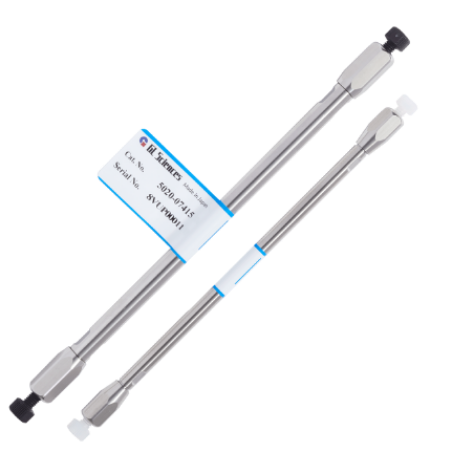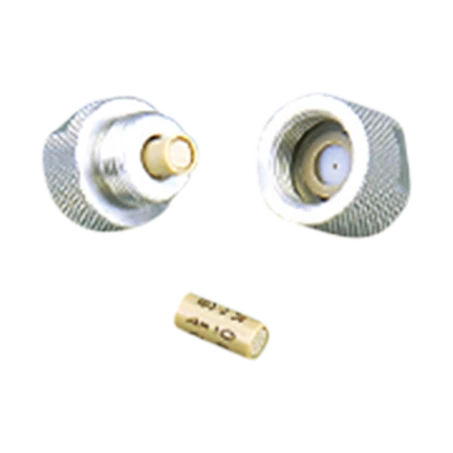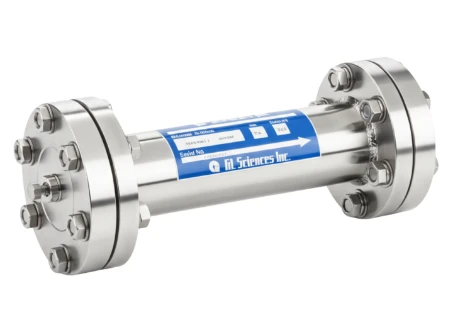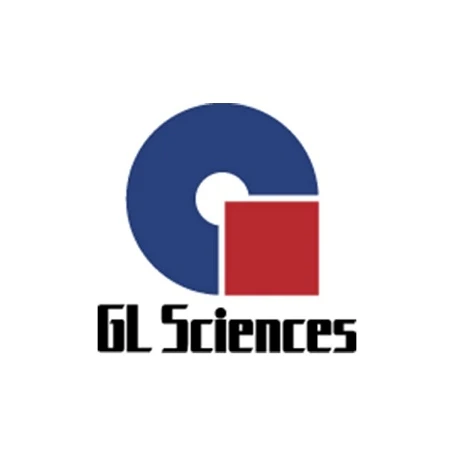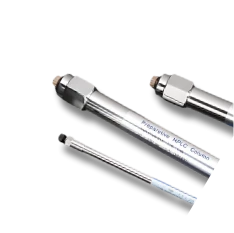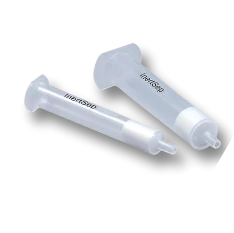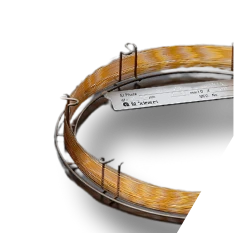- HPLC Columns
- Close Menu ×
- C18 Columns
- Core-shell Columns
- C8 & C4 HPLC Columns
- HILIC HPLC Columns
- PFP & Phenyl HPLC Columns
- Bioseparation LC columns
- SEC HPLC Columns
- All HPLC Columns
- InertSustain C18 First choice for ultra-high inertness and high durability, delivering superior peak shapes with low back pressure.
- Inertsil ODS-3 Most popular C18, trusted for long-established methods, offering strong retentivity and high loading capacity.
- InertSustain AQ-C18 First choice for high-polarity compounds, delivering strong retention even under 100% aqueous mobile phases.
- Inertsil ODS-3V Validated version of ODS-3, designed for GLP/GMP compliance, ensuring batch-to-batch consistency.
- InertSustainSwift C18 Ultra-inert, fast-separation C18 for high-throughput LC-MS and LC-MS/MS with superior peak symmetry.
- InertSustain AX-C18 Mixed-mode C18 with anion exchange for strong retention of highly polar acidic compounds without ion-pairing.
- All C18 Columns visible-xs
- InertCore Biphenyl Core-shell biphenyl for UHPLC/HPLC with superior π-π selectivity and strong retention of aromatic compounds.
- InertCore C8 Core-shell C8 for UHPLC/HPLC with moderate hydrophobicity, enabling fast, efficient, reproducible separations.
- InertCore Plus C18 Core-shell C18 for UHPLC/HPLC with superior reproducibility, durability, and sharp peaks.
- InertSustain C8 Ultra-inert C8 column for rapid analysis of hydrophobic compounds with symmetric peaks across a wide pH range.
- Inertsil C8 Ultra-pure silica C8 column for rapid analysis of hydrophobic compounds, ideal for legacy methods.
- InertSustainSwift C8 Ultra-inert C8 column for low-polarity analytes, peptides, and oligonucleotides with optimized 200Å pore size.
- Inertsil C8-3 Strong retentivity, very inert, and low back pressure, based on the same silica and bonding as Inertsil ODS-3.
- Inertsil WP 300 Wide-pore C8 column for rapid, high-resolution separation of proteins and peptides with sharper peaks.
- Inertsil C4 Low-retentivity C4 column for rapid analysis of highly hydrophobic compounds like fat-soluble vitamins.
- All C8 & C4 Columns visible-xs
- InertSustain Amide First choice for HILIC mode, offering the strongest retention of polar compounds with superior stability in water-rich conditions.
- Inertsil HILIC Diol-bonded HILIC column for excellent peak shape and strong retention of highly polar basic compounds.
- InertSustain NH2 First choice for sugar analysis, offering superior stability, reproducibility, and compatibility with weakly acidic eluents.
- Inertsil NH2 Aminopropyl column for sugar analysis, highly retentive in normal phase with superior stability and reproducibility.
- ProteoSil HILIC Bioseparation-focused HILIC column, excelling in hydrophilic compound, peptide, glycan, and oligonucleotide analysis.
- All HILIC Columns visible-xs
- InertSustain PFP A pentafluorophenyl-modified column designed for enhanced separation of structurally similar compounds through multiple retention mechanisms, including π-π, dipole, and hydrogen bonding interactions.
- InertSustain Phenyl A directly bonded phenyl group gives the InertSustain Phenyl column unique reversed-phase selectivity, ideal for separating polar compounds and structural isomers via π-π and hydrogen bonding interactions.
- InertSustain Phenylhexyl A phenylhexyl-bonded column that offers complementary selectivity to traditional alkyl-chain columns, providing high inertness, reproducibility, and low back pressure.
Get the Right Column for Your Compound — InstantlyWhat compound are you analyzing? - Sample Preparation
- Close Menu ×
- SPE Cartridges & Columns
- Spin Columns
- Proteomics Products
- InertSep QuEChERS kit
- Cleanup/Separating Bulks
- SPE Manifolds
- ALL Sample Preparation
- InertSep C18 Silica sorbent with high end-capping, ideal for lipid removal & pesticide residue analysis.
- InertSep C18-ENV C18 sorbent with low end-capping, optimized for water analysis & anionic surfactant removal.
- InertSep HLB Versatile SPE column for extracting non-polar to highly polar compounds, with a wide pH range (1-14).
- InertSep C8 Silica sorbent with octyl groups, offering weaker retention than C18 for highly retained compounds.
- InertSep SCX Silica-based SPE column with strong cation exchange and non-polar interactions for enhanced retention.
- InertSep SAX Monofunctional C18 sorbent with medium end-capping, allowing secondary interactions for versatile use.
- All SPE Cartridges & Columns visible-xs
- MonoSpin C18 High-permeability spin column for peptide desalting, drug extraction, and fast biological sample preparation.
- MonoSpin ProA Fast Protein A spin column for high-purity IgG antibody purification with >90% recovery.
- MonoSpin C18-CX Mixed-mode spin column with C18 and cation exchange for enhanced basic drug recovery.
- MonoSpin Phospholipid TiO₂/ZrO₂-coated spin column for efficient phospholipid removal and matrix effect reduction.
- MonoSpin SAX Strong anion exchange spin column for fast extraction of acidic drugs with high recovery.
- MonoSpin TiO TiO₂ spin column for phospholipid removal and organophosphorus pesticide purification.
- All Spin Columns visible-xs
- Exosome Purification
- Desalting
- Digestion
- Fractionation
- Phosphopeptide Enrichment
- Centrifuge Accessories
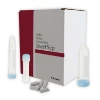 InertSep QuEChERS Kit High-purity extraction and cleanup kit for pesticide residue analysis in food and environmental samples.
InertSep QuEChERS Kit High-purity extraction and cleanup kit for pesticide residue analysis in food and environmental samples.
Get the Right Column for Your Compound — InstantlyWhat compound are you analyzing? - GC Columns
- InertCap 1MS General purpose, Hydrocarbons, PCBs, High Volatile solvents, Phenols
- InertCap 1 General purpose, Hydrocarbons, PCBs, High Volatile solvents, Phenols
- InertCap 5MS/Sil General purpose, Halogenated compounds, Phenols, Pesticides, FAME
- InertCap 5MS/NP General purpose, Halogenated compounds, Phenols, Pesticides, FAME
- InertCap 5 General purpose, Halogenated compounds, Phenols, Pesticides, FAME
- InertCap 624MS Residual solvents of Pharmaceuticals, VOCs, Alcohols
- All GC Columns visible-xs
Get the Right Column for Your Compound — InstantlyWhat compound are you analyzing? - Instruments
 LD249 Gas Leak Detector Compact, easy-to-use leak detector with thermal conductivity sensor for fast, accurate gas detection. Replaces the LD239.
LD249 Gas Leak Detector Compact, easy-to-use leak detector with thermal conductivity sensor for fast, accurate gas detection. Replaces the LD239.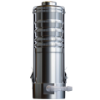 FM4: Air Sampler for PFAS Low-volume air sampler for PFAS enabling comprehensive analysis of both gas and particle phases in a single sampling using stage-optimized materials.
FM4: Air Sampler for PFAS Low-volume air sampler for PFAS enabling comprehensive analysis of both gas and particle phases in a single sampling using stage-optimized materials.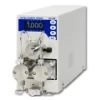 Intelligent Pump UI-32 Series Next-generation dual-plunger HPLC pump with ultra-low pulsation and automated pressure control for flow chemistry.
Intelligent Pump UI-32 Series Next-generation dual-plunger HPLC pump with ultra-low pulsation and automated pressure control for flow chemistry.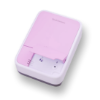 OralChroma Halitosis Measuring Device High-precision breath analyzer using gas chromatography to quantify VSCs in 4 minutes — fast, reliable, and maintenance-free.
OralChroma Halitosis Measuring Device High-precision breath analyzer using gas chromatography to quantify VSCs in 4 minutes — fast, reliable, and maintenance-free.
 LD249 Gas Leak Detector Latest model replacing LD239, with thermal conductivity detection for helium, hydrogen, and other gases.
LD249 Gas Leak Detector Latest model replacing LD239, with thermal conductivity detection for helium, hydrogen, and other gases.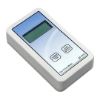 GF1010 Digital Gas Flowmeter Portable, volumetric meter for accurate GC gas flow measurement without gas selection.
GF1010 Digital Gas Flowmeter Portable, volumetric meter for accurate GC gas flow measurement without gas selection.
 Intelligent Pump UI-32 Series Next-generation dual-plunger HPLC pump with ultra-low pulsation and automated pressure control for flow chemistry.
Intelligent Pump UI-32 Series Next-generation dual-plunger HPLC pump with ultra-low pulsation and automated pressure control for flow chemistry.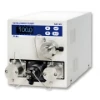 Intelligent Micro Pump MP-32 Series Compact micro pump with ultra-low pulsation and high-pressure stability, ideal for flow chemistry and precision dosing.
Intelligent Micro Pump MP-32 Series Compact micro pump with ultra-low pulsation and high-pressure stability, ideal for flow chemistry and precision dosing.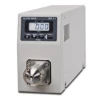 Auto BPR BP-11 Auto Back Pressure Regulator for the UI-22 Series, maintaining stable pressure for consistent flow.
Auto BPR BP-11 Auto Back Pressure Regulator for the UI-22 Series, maintaining stable pressure for consistent flow.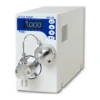 PCS Pump SP-32 Series Single plunger pump with real-time pressure control and low-pulsation flow—ideal for precise fluid delivery.
PCS Pump SP-32 Series Single plunger pump with real-time pressure control and low-pulsation flow—ideal for precise fluid delivery.- All HPLC Pumps visible-xs
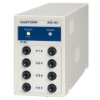 Gastorr AG Series Reliable, CPU-controlled degassing system for low-flow applications with independent chamber design.
Gastorr AG Series Reliable, CPU-controlled degassing system for low-flow applications with independent chamber design.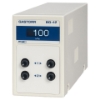 Gastorr BG Series High-performance degassing system with real-time vacuum display and independent chamber design.
Gastorr BG Series High-performance degassing system with real-time vacuum display and independent chamber design. Gastorr FG-42 Solvent degassing system optimized for fluorinated solvents with real-time vacuum display.
Gastorr FG-42 Solvent degassing system optimized for fluorinated solvents with real-time vacuum display.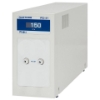 Gastorr PG Series High-flow degassing system for fractionating applications with real-time vacuum display.
Gastorr PG Series High-flow degassing system for fractionating applications with real-time vacuum display.- All Degassing Units visible-xs
- Accessories
- Close Menu ×
- HPLC Accesories
- SPE Accessories
- GC Accessories
- HPLC Tubing
- Filters
- HPLC Fittings
- Solvent Bottle Caps and Other Accessories
- Gradient Mixer
- Regulator
- IDEX Accessories
- HPLC Column Hardware and Other Accessories
- Vials
- SPE Vacuum Manifolds
- SPE Gravity Manifolds
- Cleanup/Separating Bulks
- Glass Chromatography Columns
- General SPE Accessories
- Applications & Industries
- Close Menu ×
- Featured
- PFAS Solutions Products and workflows for EPA and ISO-compliant PFAS testing in water, air, and soil.
- Flow Chemistry Solutions Integrated pumps and pressure regulators for continuous, high-temperature flow chemistry reactions.
- Life Science/Bio Products Spin columns and purification tools for antibody capture, protein cleanup, and bioseparation workflows.
- Gas/Air Sampling Equipment Sampling tools for capturing VOCs, aldehydes, and trace gases in environmental and industrial settings.
- Resources
- About
- Contact Us
Search
You have no items in your shopping cart.
HPLC Columns & LC Columns
GL Sciences HPLC columns deliver clean peak shape, high inertness, and reproducible results — trusted by method developers in validated methods and regulated labs.

Featured Products
Types of HPLC Columns: Which Column Should You Choose?
HPLC columns are available in a wide range of types, each designed to address specific analytical challenges depending on the nature of compounds to be separated. Understanding the different separation mechanisms helps ensure you select the column that delivers optimal retention, selectivity, and resolution for your analysis.
Reversed Phase HPLC Columns
Reversed phase columns are the most commonly used in liquid chromatography due to their wide variety of commercially available phases and effectiveness in separating a wide range of compounds. These columns feature a non-polar stationary phase, typically composed of silica particles bonded with hydrophobic ligands such as alkyl chains, phenyl or cyano groups. The C18 column is named after the bonded octadecyl ligand that provides the main separation mechanism via its 18-carbon alkyl chain.
💡 C18 columns are the most widely used reversed-phase columns. Learn more in our C18 HPLC Columns Guide →
Reversed phase columns are popular because most analysts are trained on this technique and reversed phase separations provide consistent retention times for analytes separated based on their hydrophobicity, while normal phase is notorious for shifting retention times if care is not taken during mobile phase preparation. The mobile phase is often a mixture of water, methanol, or acetonitrile, and compounds are eluted in order of decreasing polarity/increasing hydrophobicity.
Recommended Reverse Phase HPLC Columns
| HPLC Column | Features | USP Code | Particle Size (µm) | Pore Size (nm) | Surface Area (m²/g) |
| InertSustain C18 | First choice with ultra high inertness and high durability | L1 | 2, 3, 5, 10 | 10 | 350 |
| InertSustain AQ-C18 | First choice for high polar compounds | L1, L96 | 1.9, 3, 5 | 10 | 350 |
| InertSustainSwift C18 | First analysis with ultra high inertness and high durability | L1 | 1.9, 3, 5 | 20 | 200 |
| InertSustain AX-C18 | Analysis of anionic highly polar compounds | L1, L78 | 3, 5 | 20 | 200 |
| InertCore Plus C18 | Ideal for analyses requiring a high number of theoretical stages | L1 | 2.6 | 9 | 200 |
| Inertsil ODS-HL | Ultra high retentivity, High-density bonding of C18 phase | L1 | 3, 5 | 10 | 450 |
| Inertsil ODS-4 | Ultra high inertness, High plate count, Medium retentivity | L1 | 2, 3, 5 | 10 | 450 |
| Inertsil ODS-4V | Inertsil ODS-4 Validated column | L1 | 3, 5 | 10 | 450 |
| Inertsil ODS-3 | Strong retentivity, Lower column backpressure, Very inert | L1 | 2, 3, 4, 5, 10 | 10 | 450 |
| Inertsil ODS-3V | Inertsil ODS-3 Validated column | L1 | 3, 5 | 10 | 450 |
| Inertsil ODS-SP | Weak retentivity, for hydrophobic compounds | L1 | 3, 5 | 10 | 450 |
| Inertsil ODS-P | High steric selectivity | L1 | 3, 5 | 10 | 450 |
| Inertsil ODS-EP | A polar functional group embedded | L1 | 5 | 10 | 450 |
| Inertsil WP300 C18 | Analysis of high molecules | L1 | 5 | 30 | 150 |
| Inertsil ODS-2 | Ultra pure silica gel is used | L1 | 5 | 15 | 320 |
| Inertsil ODS | Inertness 1st generation | L1 | 5, 10 | 10 | 350 |
| InertSustain C8 | First choice with ultra high inertness and high durability | L7 | 2, 3, 5 | 10 | 350 |
| InertSustainSwift C8 | High inertness and high durability C8 column | L7 | 1.9, 3, 5 | 20 | 200 |
| Inertsil C8-4 | Ultra high inertness, High plate count, Low retentivity | L7 | 2, 3, 5 | 10 | 450 |
| Inertsil C8-3 | Strong retentivity, Lower column backpressure, Very inert | L7 | 2, 3, 5, 10 | 10 | 450 |
| Inertsil C8 | Ultra pure silica gel is used | L7 | 5 | 15 | 320 |
| Inertsil C4 | Low retentivity | L26 | 5 | 15 | 320 |
| Inertsil WP300 C8 | Suitable for high molecules | L7 | 5 | 30 | 150 |
| Inertsil WP300 C4 | Suitable for high molecules | L26 | 5 | 30 | 150 |
| InertSustain PFP | Extremely Strong retention of highly polar basic compounds | L43 | 3, 5 | 10 | 350 |
| InertSustain Phenylhexyl | Strong π-π interactions and hydrophobic interactions | L11 | 3, 5 | 10 | 350 |
| InertSustain Phenyl | Extremely strong π-π interactions | L11 | 2, 3, 5 | 10 | 350 |
| Inertsil Ph-3 | Strong π-π interactions | L11 | 2, 3, 5 | 10 | 450 |
| Inertsil Ph | High inertness, Weak π-π interactions | L11 | 5 | 15 | 320 |
| InertSustain Cyano | Ultra inertness and can be used in reversed phase mode | L10 | 3, 5 | 10 | 350 |
Learn More: Reversed Phase Column Selection Guide → | Selectivity Comparison of RP Columns →
Quick Links
Need Expert Help?
Connect with a GL Sciences specialist for personalized column recommendations.
Contact Expert →Normal Phase HPLC Columns
Normal phase columns employ a polar stationary phase, typically consisting of materials like silica gel, cyano, amino, or diol types. The mobile phase, in contrast, is non-polar and commonly composed of aliphatic hydrocarbons such as hexane or cyclohexane, or aromatic hydrocarbons like toluene. Normal phase was the first type of LC developed, hence the term "reversed phase" for the opposite mechanism.
For normal phase separations, substances soluble in organic solvents are eluted in order of increasing polarity - less polar molecules have fewer interactions with the polar stationary phase, while more polar analytes show greater retention with stronger interactions.
Recommended Normal Phase HPLC Columns
| HPLC Column | Features | USP Code | Particle Size (µm) | Pore Size (nm) | Surface Area (m²/g) |
| Inertsil Diol | First choice for normal phase mode, also for SEC | L20 | 3, 5 | 10 | 450 |
| Inertsil SIL-100A | Ultra pure silica gel with 100Å pore size | L3 | 3, 5 | 10 | 450 |
| Inertsil SIL-150A | Ultra pure silica gel with 150Å pore size | L3 | 5 | 15 | 320 |
| Inertsil WP300 SIL | Ultra pure silica gel with 300Å pore size | L3 | 5 | 30 | 150 |
| Inertsil CN-3 | Can also be used in reversed phase mode | L10 | 3, 5 | 10 | 450 |
HILIC HPLC Columns (Hydrophilic Interaction Liquid Chromatography)
HILIC is a variant of normal phase liquid chromatography that overlaps with ion-exchange and reversed phase HPLC. HILIC columns are specifically designed to separate polar to highly polar compounds that are poorly retained in traditional reversed phase HPLC. These columns utilize hydrophilic stationary phases with reversed phase type eluents.
Longer re-equilibration times are required to create correct and reproducible conditions for HILIC separation mechanisms. While there is ongoing discussion about the main separation mechanisms employed in HILIC, it combines NP, ion exchange, and RP mechanisms. The highly organic conditions make HILIC highly compatible with mass spectrometry (MS) detection, where volatile and ionizable separation conditions aid in the ionization stage for improved MS detection.
Recommended HILIC HPLC Columns
| HPLC Column | Features | USP Code | Particle Size (µm) | Pore Size (nm) | Surface Area (m²/g) | Carbon Loading (%) | Recommended pH Range |
| InertSustain Amide | First choice column for HILIC mode. | L68 | 3, 5 | 10 | 350 | 15 | 2 - 8.5 |
| Inertsil Amide | Effective when the retention of high polar compounds is further strengthened. | L68 | 3, 5 | 10 | 450 | 18 | 2 - 7.5 |
| Inertsil HILIC | Effective when the overall retention is to be reduced or when the separation pattern is to be changed. | L20 | 3, 5 | 10 | 450 | 20 | 2 - 7.5 |
| InertSustain NH2 | First choice column for sugar analysis. | L8 | 3, 5 | 10 | 350 | 7 | 2 - 7.5 |
| Inertsil NH2 | Effective for intensifying retention in sugar analysis | L8 | 3, 5 | 10 | 450 | 8 | 2 - 7.5 |
Learn More: Normal Phase & HILIC HPLC Column Selection Guide →
Ion Exchange Chromatography HPLC Columns
Ion exchange chromatography separates charged ions in sample mixtures by utilizing ion exchange resins that facilitate different interaction strengths based on relative ionic affinities. The stationary phases consist of bonded groups with ionizable functional groups that bind to specific ions, while the mobile phase is controlled with specific pH, ionic strength, buffer type, and buffer concentration.
Ion exchange columns are widely used for purifying proteins, nucleic acids, and other charged analytes, making them essential tools in bioseparations and environmental, water, or industrial applications.
Recommended ION Exchange HPLC Columns
| HPLC Column | Features | USP Code | Particle Size (µm) | Pore Size (nm) | Surface Area (m²/g) |
| Inertsil AX | Anion exchange column | - | 5 | 10 | 450 |
| Inertsil CX | Cation exchange column | L9 | 5 | 10 | 450 |
Size Exclusion Chromatography (SEC) Columns
Size exclusion chromatography, also known as gel filtration or gel permeation chromatography, separates molecules based on their size as they pass through a stationary phase, without other competing separation mechanisms. Larger molecules are restricted and unable to access the pores of the stationary phase, hence elute first. Smaller molecules can access the pores, enter the porous stationary phase, and are retained longer compared to larger molecules.
These columns are widely used in purification and analysis of biomolecules such as proteins, enzymes, polysaccharides, nucleic acids, and other large macromolecules including polymers, providing separations based solely on molecular size.
Recommended SEC HPLC Columns
| HPLC Column | Features | USP Code | Particle Size (µm) | Pore Size (nm) | Surface Area (m²/g) |
| Inertsil WP300 Diol | High molecule SEC, Can be also used in normal phase mode | L20, L33 | 5 | 30 | 150 |
Superficially Porous Particle (SPP) / Solid-core Packed HPLC Columns
These columns feature a unique particle technology compared to the typical fully porous particle (FPP) based columns. They were introduced and are an alternative to achieve increased column efficiencies without the expense of higher backpressures. The particle architecture comprises of an inner non-porous/impermeable central core that is surrounded by a superficially porous layer.
The design of SPP has been shown to reduce the resistance to mass transfer contribution, and to minimize peak broadening/dispersion with its relatively shorter diffusion path length compared to FPP (the FPP central core can be penetrated and provides inefficient zones of dispersion). This shorter diffusion path results in less longitudinal dispersion of solutes, resulting in narrower peaks and improved separation efficiency. While the impermeable core is directly related to reducing the backpressure at higher flowrates/velocities reactive to FPP of the same size.
Recommended SPP / Solid-core Packed HPLC Columns
| HPLC Column | Features | USP Code | Particle Size (µm) | Pore Size (nm) | Surface Area (m²/g) |
| InertCore Plus C18 | Ideal for analyses requiring a high number of theoretical stages | L1 | 2.6 | 9 | 200 |
Preparative Scale HPLC Columns
Preparative HPLC Columns are specialized chromatography columns with large internal diameters, designed for the purification and isolation of large quantities of chemical compounds. These larger ID columns operate at higher flow rates relative to analytical scale columns (4.6 mm ID), the separation is focused on extracting/purifying a compound of interest and is evaluated based on yield and purity.
Key applications include purifying active pharmaceutical ingredients, proteins, and natural products. While preparative HPLC is resource-intensive and requires a larger column, instrumentation, and solvent consumption. It offers increased scalability and versatility for processing significant quantities of material, making it essential for both manufacturing and production purposes/processes.
Recommended Preparative HPLC Columns:
GL Sciences offers preparative columns across reversed phase, size exclusion, HILIC, and normal phase categories.
HPLC Guard Columns (Guard Holder and Replaceable Guard Cartridges)
The ‘guard column’ can be thought of as the replaceable initial inlet part of the HPLC column that is susceptible to blocking and contamination from the sample and the system. Hence, instead of exposing these problems to the expensive HPLC column, placing a relatively cheaper guard column in front can extend the HPLC column’s lifetime. The guard column should be similar to the analytical column, as the guard columns are positioned before the analytical column. When the guard column becomes contaminated/blocked, it is easily replaced, instead of replacing the more expensive HPLC column. Therefore, selecting the right guard column is important.
Learn more: How To Select The Right HPLC Guard Column →
HPLC Guard Columns (Guard Holder and Replaceable Guard Cartridges)
The ‘guard column’ can be thought of as the replaceable initial inlet part of the HPLC column that is susceptible to blocking and contamination from the sample and the system. Hence, instead of exposing these problems to the expensive HPLC column, placing a relatively cheaper guard column in front can extend the HPLC column’s lifetime. The guard column should be similar to the analytical column, as the guard columns are positioned before the analytical column. When the guard column becomes contaminated/blocked, it is easily replaced, instead of replacing the more expensive HPLC column. Therefore, selecting the right guard column is important.
Learn more: How To Select The Right HPLC Guard Column →
Need Expert Help?
Connect with a GL Sciences specialist for personalized column recommendations.
Contact Expert →
How to Choose a Column for HPLC
The column is the most important aspect for all separations, as this is where the stationary phase resides, and provides the main separation mechanism. The stationary phase’s tightly packed bed is enclosed/encased in a cylindrical space/tube of a specific length and internal diameter. Most columns are made out of stainless steel, while PEEK (polyetheretherketone) or glass are also used. Inert surfaces may also be employed for specific separations that are very sensitive to the column’s material where interactions can also occur.
The selection of an HPLC column, amongst all the different HPLC column types is a critical set of decisions that can significantly impact the retention, efficiency, selectivity and hence the resolution as well as the reproducibility of the separation process.
Key factors during the column selection decision include:
Particle Size / Particle Technology
- Efficiency: The particle size of the stationary phase material directly affects the column’s efficiency/performance. Smaller particles were developed to provide a higher number of theoretical plates (N) at the expense of increased backpressure and suffer from frictional heating peak dispersion/broadening effects.
- Columns with sub-2 µm particles must be employed and used with instrumentation that can be operated at ultra-high-pressure environments (>600 bar and up to 1500 bar) - this specific technique is known as ultra high pressure liquid chromatography (UHPLC).
- While smaller particles enhance efficiency, they require knowledge and expertise to exploit their benefits and understand the theoretical and practical drawbacks of using ultra high pressures for their separations. For example, understanding frictional heating peak broadening/dispersion effects. Also, to take into account how they are packed with smaller sized frits that are sensitive to blockage and/or contamination, hence, require very clean laboratory practices with sample and mobile phase preparation.
- Particle technology: The most commonly used type of particle are fully porous particles (FPP). Superficially porous particles (SPP), also known as solid-core, core-shell, pellicular particles, are an alternative particle that have practical benefits of increased efficiency at lower backpressures relative to FPP of the same size.
- Particle technology: The most commonly used type of particle are fully porous particles (FPP). Superficially porous particles (SPP), also known as solid-core, core-shell, pellicular particles, are an alternative particle that have practical benefits of increased efficiency at lower backpressures relative to FPP of the same size.
Column Dimensions / Format
- Length (L): The length of the column is directly related to the column efficiency/performance associated to the metric known as the number of theoretical plates (N). Typical lengths are between 5-25 cm.
- Long column lengths: provide a higher N, increased column performance, at the expense of increased analysis time due to the increase of the column’s dead time (T0) contribution (an important metric that the analyst must also be familiar with). Increasing L, increases solvent consumption, and back-pressure. They are suitable for complex mixtures where maximum column performance is necessary.
- Reduction of column length: this is acceptable as long as column efficiency remains sufficient for the separation aims/objectives/goals. Reducing L, reduces T0, and may decrease the analysis time and back pressure.
- Diameter: The internal diameter (ID) of the column is selected based on the separation’s sample injection volume, loading capacity, velocity/flowrate and sensitivity. The typically employed ID dimension is between 2.1 and 4.6 mm for analytical scale separations. Wider bore columns >4.6 mm ID allow for larger sample volumes. These IDs are good options for purification applications, where large injection volumes are employed.
- ‘Narrow-bore’ columns of 2.1 mm or smaller are used for applications with limited sample volumes and/or concentrations. Employed to increase the detection sensitivity of the analysis with a reduced injection volume.
- Reducing the ID of a column lead to a loss of column performance due to the column wall effect becoming a larger contributing factor to peak dispersion/broadening effects.
Temperature and Flow Rate
- Temperature: Column temperature can enhance separation efficiency. Increasing the temperature is highly beneficial for reducing the solvent viscosity, allowing for faster flow rates to be used at reduced backpressure. Increasing the mass transfer kinetics between the analytes and the mobile and stationary phase. It is one of the most underutilized practical parameters that can easily change the selectivity, efficiency and retention of the separation, hence the resolution. Analysts must ensure that the analytes and stationary phase and system are thermally stable/compatible under the chosen elevated temperature conditions by checking with the manufacturers’ operational limits.
- Flowrate: The flowrate/velocity of the mobile phase is tightly coupled to the performance of the column. The classical and historical Van Deemter curve experiments highlights this dependency and is also another parameter underutilized, not many laboratories use the Van Deemter curve minimum/optimum velocity for their flow rate selection. Often use flowrates based on how long can they can afford to spend on each injection, or use the flowrate associated to the certificate of analysis of the purchased column. Higher flow rates reduce analysis time but may compromise separation column performance and increase backpressure, particularly with UHPLC columns. Also, we must note that detectors such as mass spectrometry (MS) as well as evaporative light scattering and charged aerosol detectors are sensitive to volumetric flowrate changes, hence, if the detection techniques are prioritized, this is also an aspect that will effect the selection of an appropriate flowrate and column format.
Stationary Phase Chemistry
Lorem Ipsum is simply dummy text of the printing and typesetting industry. Lorem Ipsum has been the industry's standard dummy text ever since the 1500s, when an unknown printer took a galley of type and scrambled it to make a type specimen book.
Particle
- Selectivity/bonded phase/bonded chemistry/bonded moeity/bonded ligand: Selectivity in general is the key approach to achieving higher resolution separations. The most common way is to change the mobile phase selectivity, and the easiest approach is to change to change the temperature. However, the parameter that is highly impactful is to change the HPLC column stationary phase chemistry.
- Analytes are often separated based on their hydrophobic characteristics via reversed phase (RP) columns with hydrophobic bonded chemistries. Analytes can also be separated based on their polarity via normal phase (NP) columns with polar stationary phase chemistries. Very polar analytes may be separated using hydrophilic interaction liquid chromatography (HILIC) stationary phase columns.
- RP columns are the most employed and the C18 column has become one of the most utilized columns in validated methods. We must not ignore that there are other interactions/mechanisms that can be exploited to improve the selectivity and resolution of the separation. Alternative/specialized stationary phases are available for unique or more complex separation challenges, such as chiral separations or the analysis of highly polar or ionic compounds.

